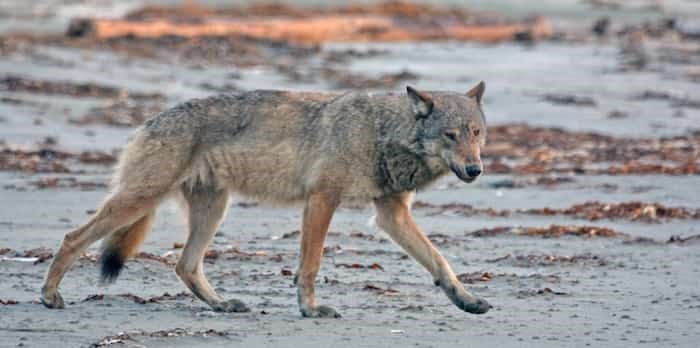“Dave woke up with wolves snarling around the tent all night,” she says.
Except when they poked their heads out in the morning, the pawprints and tufts of grey fur showed the roughhousing wolves had been after each other, not the Port Alberni couple who had set up camp on the remote north end of the Hesquiat Peninsula.
Later, Windh was able to photograph the wolves, even capturing video of one ripping apart a sea lion. What a thrill.
Windh and David Gilbert are home now, their month-long trek down a rugged, all-but-unpopulated stretch of Vancouver Island’s west coast complete.
You might have read about it June 7, just before a float plane carried them to the beginning of a boots-and-paddles journey that saw them hike the Tatchu Peninsula, Nootka Island and Hesquiat Peninsula before picking up kayaks for the final leg to Tofino.
It was just the latest in a series of adventures that has taken the couple to back-of-beyond places as far-flung as the Himalayas, the Andes and the Kalahari Desert. This destination might have been closer to home but still was so remote that it remains unknown to most of us.
That’s why the trip, which photojournalist Windh plans to turn into a book, was dubbed the Secret Coast Expedition.
Except when they poked their heads out in the morning, the pawprints and tufts of grey fur showed the roughhousing wolves had been after each other, not the Port Alberni couple who had set up camp on the remote north end of the Hesquiat Peninsula.
Later, Windh was able to photograph the wolves, even capturing video of one ripping apart a sea lion. What a thrill.
Windh and David Gilbert are home now, their month-long trek down a rugged, all-but-unpopulated stretch of Vancouver Island’s west coast complete.
You might have read about it June 7, just before a float plane carried them to the beginning of a boots-and-paddles journey that saw them hike the Tatchu Peninsula, Nootka Island and Hesquiat Peninsula before picking up kayaks for the final leg to Tofino.
It was just the latest in a series of adventures that has taken the couple to back-of-beyond places as far-flung as the Himalayas, the Andes and the Kalahari Desert. This destination might have been closer to home but still was so remote that it remains unknown to most of us.
That’s why the trip, which photojournalist Windh plans to turn into a book, was dubbed the Secret Coast Expedition.
The journey had the blessing of the Royal Canadian Geographic Society, of which Windh is a fellow, and the Spanish Embassy, which was keen to highlight the little-known history of Spain’s time on this coast more than 200 years ago.
It turned out the couple needed all their meticulous planning.”
I wouldn’t say I bit off more than I could chew, but I bit off more than I realized,” Windh says.
The challenges included one episode in which their path was blocked by a steep, irregular rocky outcropping where water raged up surge channels. After struggling up a precarious path where the slightest misstep would send them plunging to the rocks and ocean below — “It was quite scary” — it took ages to find an old bear trail that would allow them to keep going. By then it was too late in the day to continue, so they climbed back down and camped. The next day they ascended the rocks again, left their backpacks, hacked through maybe 300 metres of bear-trail bush, then returned for their gear. They had to hurry to make a pre-arranged rendezvous with a boat to take them from Port Eliza to Nootka Island.
Most of the hike had a more natural rhythm, though.
“Physically it was hard, but mentally it was really easy to be out there.”
Wolves weren’t the only wildlife they encountered. “On the first section, we had so many close encounters with bears,” Windh says.
A pod of orcas put on an hour-long show one day. A stinky sea lion settled in nearby one night.
At Nootka Island, Windh shooed out to sea a listless baby grey whale she found wallowing in the shallows. Ray and Terry Williams, the only full-time residents of the historic Indigenous community at Yuquot — or Friendly Cove — tried to keep an eye on the sickly whale, but it disappeared. “He must have died overnight,” Windh says.
It was Ray Williams who also passed on a history lesson, showing the place where the Mowachaht stood on the roofs of their longhouses, holding burning spruce boughs to illuminate the high-tide launch of a ship called the North West America in 1788. Built under the direction of British captain John Meares, it was the first European-style vessel built in these waters. It was later captured by the Spanish and dismantled in what is now Mexico.
Windh and Gilbert ate well during their month away, their provisions augmented by urchins, gooseneck barnacles, four or five types of clams and a couple of fish that Gilbert caught (though it was a bit unnerving when a pair of wolves parallelled him along the high-tide line one day as he strode beside the surf with a haul of freshly collected seafood). “We had fresh greens almost every day,” Windh says.
While wildlife was plentiful, other humans weren’t.
“The first week, we didn’t see anybody at all.”
They finally ran into a pair of hikers on Nootka Island, then a couple of groups on the Hesquiat Peninsula.
It wasn’t until they picked up their kayaks at Cougar Annie’s Garden that they really began to see signs of people — the most welcome of whom were Wickaninnish Inn owner Charles McDiarmid and a couple of staff who waded out to meet them with champagne when they paddled into Tofino.




